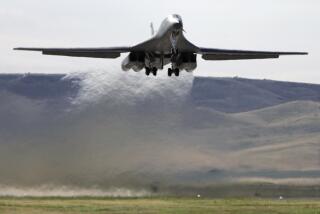Wrong Computer Program Sent Rocket Astray
CAPE CANAVERAL, Fla. — Launch controllers loaded the wrong computer program into the guidance unit of a rocket that had to be destroyed last week when it veered sharply off course, a Pentagon official said Monday.
No one bothered to check printouts that showed the error, said Michael Griffin, deputy for technology at the Pentagon’s Strategic Defense Initiative Organization.
The 29-foot Aries rocket was blown up Tuesday 23 seconds after being launched with “Star Wars” experiments from Cape Canaveral Air Force Station. Instead of heading northeast over the Atlantic, the rocket had sped south.
The burning wreckage fell onto a remote area of the Air Force station. The cost, not counting the experiments, was $5 million.
A technician accidentally hit the wrong key when loading software into the rocket’s guidance and control unit just before liftoff, Griffin said. As a result, ground test software rather than flight software was sent into on-board computers, causing the steering nozzles to lock in place, he said.
Controllers never checked to make sure the proper computer program had been loaded, Griffin said. The mistake was evident on computer printouts, but no one looked at them, he said.
An SDI spokeswoman, Maj. Carolyn Channave, said top Pentagon officials “definitely are going to be looking into this.”
The launching operations were conducted by rocket maker Orbital Sciences Corp. of Fairfax, Va. Orbital Sciences spokeswoman Laura Ayres said the company had no comment regarding the mistakes.
Another computer problem has grounded a similar rocket that is supposed to carry more “Star Wars” experiments as part of a target-tracking test. That launching, originally set for last Friday, is off until at least next week, SDI officials said.
The short, suborbital Aries flights are part of SDI’s Red Tigress program for the development of missile-detecting sensors.
SDI officials have refused to discuss the experiments, which are classified. But civilian space analysts said they believe infrared sensors on the ground and on aircraft were to be used to track the rocket in an effort to learn how to distinguish enemy missiles.
More to Read
Sign up for Essential California
The most important California stories and recommendations in your inbox every morning.
You may occasionally receive promotional content from the Los Angeles Times.









